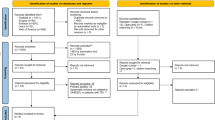Abstract
Introduction Pi and colleagues reviewed eight case-control studies comparing the oral health (decayed, missing and filled teeth [DMFT], Plaque Index [PI], Gingival Index [GI] and salivary pH) of children with autism (n = 475) to children without autism (n = 565).
Method The search strategy involved the use of PubMed, Embase, Web of Science, Cochrane Library, China National Knowledge Infrastructure (CNKI), Wanfang and Chinese Scientific and Technological Journal (VIP) to find case-control studies which met pre-defined inclusion criteria and were published before September 2018. The quality of each study was evaluated using the Newcastle-Ottowa Scale and only high-quality studies were included. Means and standard deviations for outcomes measured by each included study were presented. Data were pooled using the random-effects model via Review Manager 5.3, and presented as mean differences and 95% confidence intervals. Consistency was measured using I2. Sensitivity analysis was performed by removing one study with a large sample to explore effects on heterogeneity.
Results The authors found eight eligible case-control studies conducted in Asia (n = 7) or South America (n = 1). Six of the eight compared DMFT of children with autism to those without and three of the eight compared PI, GI and/or salivary pH. While a meta-analysis is presented for each of the oral health outcome areas, there are discrepancies in the reporting. The included studies in each of the meta-analysis do not correspond with the characteristics of the studies provided.
Conclusions The authors suggest from their meta-analyses that children with autism experience a higher prevalence of dental disease than children without autism. However, as currently presented, the study lacks internal validity and findings are not reliable.
This is a preview of subscription content, access via your institution
Access options
Subscribe to this journal
Receive 4 print issues and online access
$259.00 per year
only $64.75 per issue
Buy this article
- Purchase on Springer Link
- Instant access to full article PDF
Prices may be subject to local taxes which are calculated during checkout
Similar content being viewed by others
References
National Autistic Society. What is autism? Available at https://www.autism.org.uk/advice-and-guidance/what-is-autism (accessed January 2021).
Thomas N, Blake S, Morris C, Moles D R. Autism and primary care dentistry: parents' experiences of taking children with autism or working diagnosis of autism for dental examinations. Int J Paediatr Dent 2018; 28: 226-238.
Lam P P, Du R, Peng S, McGrath C Pj, Yiu C K. Oral health status of children and adolescents with autism spectrum disorder: A systematic review of case-control studies and meta-analysis. Autism 2020; 24: 1047-1066.
da Silva S N, Gimenez T, Souza R C et al. Oral health status of children and young adults with autism spectrum disorders: systematic review and meta-analysis. Int J Paediatr Dent 2017; 27: 388-398.
Author information
Authors and Affiliations
Corresponding author
Rights and permissions
About this article
Cite this article
Thomas, N., Blake, S. Dental disease risk in children with autism: a meta-analysis. Evid Based Dent 22, 34–35 (2021). https://doi.org/10.1038/s41432-021-0165-3
Published:
Issue Date:
DOI: https://doi.org/10.1038/s41432-021-0165-3



